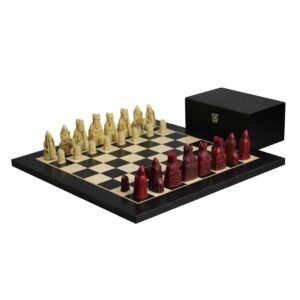
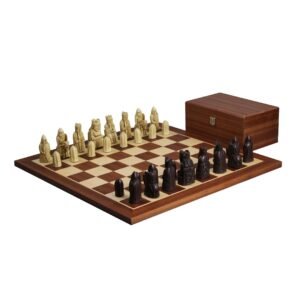
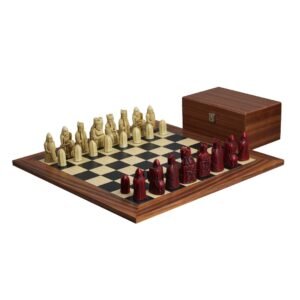


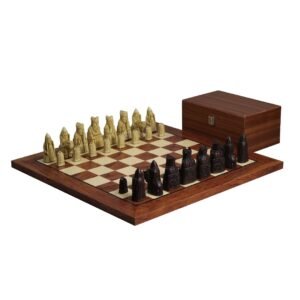
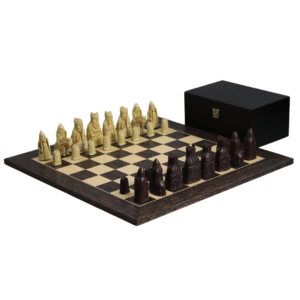

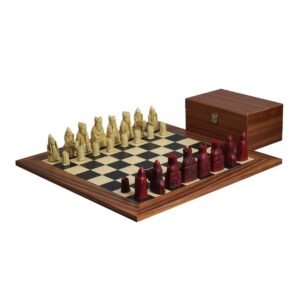


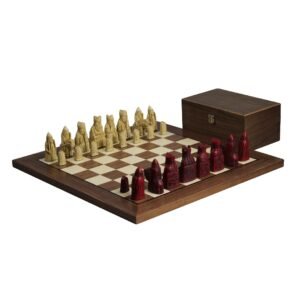




The Isle of Lewis Chess Set is more than just a collection of carved figures used for a game—it is a profound piece of history, an artistic masterpiece, and a cultural icon. This medieval treasure, discovered on the remote Isle of Lewis in Scotland, has fascinated historians, archaeologists, and chess enthusiasts for nearly two centuries. Beyond their practical use as game pieces, these extraordinary artefacts offer a glimpse into medieval society, craftsmanship, and the Norse influence on British history.
Even today, the set continues to inspire reproductions and remains a prized possession for collectors, historians, and chess lovers alike. In this article, we will explore the fascinating history, craftsmanship, cultural significance, and modern appeal of the Isle of Lewis Chess Set.
The story of the Isle of Lewis Chess Set begins in 1831, on the windswept shores of the Isle of Lewis in the Outer Hebrides of Scotland. A local man reportedly discovered the chessmen hidden within a sandbank near Uig Bay, possibly buried to protect them during turbulent times. Although accounts of the exact discovery differ, it is widely believed that the set had been hidden centuries earlier and remained undisturbed until this chance unearthing.
A total of 93 artefacts were found, including 78 chess pieces, 14 gaming pieces, and one belt buckle. These pieces were carved predominantly from walrus ivory and whale teeth, materials that were highly valued in medieval Europe. The discovery instantly captured public imagination, drawing attention from historians, collectors, and even the British monarchy.
Shortly after their discovery, most of the pieces were sold to the British Museum in London, where they remain on display today. A smaller group of pieces eventually found a home in the National Museum of Scotland in Edinburgh.
The origins of the chessmen remain shrouded in mystery. However, the craftsmanship, artistic style, and materials used suggest that they were likely made in Norway during the 12th century—a period when Scotland’s Outer Hebrides were under Norse control.
Historians generally agree that the Isle of Lewis Chess Set dates back to the 12th century and reflects strong Norse influence, likely crafted in what was then the Kingdom of Norway. During this time, the Isle of Lewis was part of the Kingdom of the Isles, a collection of islands under Norwegian rule, explaining the strong Scandinavian aesthetic seen in the pieces.
The artistry and design of the pieces closely resemble carvings from Trondheim, Norway, suggesting they may have been crafted by a skilled artisan or workshop in that region. Some historians speculate that the chessmen were part of a merchant’s cargo lost or hidden during a journey from Norway to Ireland or other parts of the British Isles.
In medieval Europe, chess was a game played primarily by the nobility and wealthy elite, symbolising intellect, strategy, and power. Owning a chess set made from expensive materials like walrus ivory would have been a clear sign of wealth and status.
One of the most remarkable aspects of the Isle of Lewis Chess Set is its stunning artistic design. Each piece is intricately carved, displaying a unique blend of functionality, symbolism, and artistic flair that offers insight into medieval society and Norse culture.
The chess pieces represent different societal roles and military ranks from medieval Europe:
What sets these pieces apart is their expressiveness. The detailed facial expressions and gestures provide a glimpse into the emotions and social roles of the time. Each figure feels alive, capturing the humanity and complexity of medieval European society.
The Isle of Lewis Chess Set is renowned not just for its artistic design but also for the craftsmanship involved in creating each piece. The original pieces were primarily carved from walrus ivory, a material that was rare, valuable, and highly prized in medieval Europe. Some pieces were also carved from whale teeth, another luxury material of the time.
Crafting a chess set from such materials required extraordinary skill and patience. Medieval artisans would have used basic tools, such as knives and chisels, to carve the intricate details seen on the Lewis Chessmen. The level of craftsmanship reflects both artistic mastery and a deep understanding of the materials used.
The time and effort involved in producing such a set suggest that it was commissioned by a wealthy patron—perhaps a noble or high-ranking official. Each piece showcases remarkable attention to detail, from the delicate carving of robes and armour to the expressive faces and symbolic gestures.
The Isle of Lewis Chess Set is more than a medieval game; it is a window into the cultural and societal structures of 12th-century Europe. The inclusion of bishops reflects the growing power of the church during the medieval period, while the presence of fierce, shield-biting berserkers highlights the enduring influence of Norse mythology and Viking culture.
These chess pieces offer a visual representation of medieval power structures, depicting kings, queens, knights, and religious figures in ways that reflect their societal importance. Beyond the battlefield of the chessboard, they illustrate the hierarchical order of medieval Europe and the values of the time—honour, bravery, strategy, and faith.
The set has also left its mark on modern popular culture. The pieces notably inspired elements of the wizard chess set in the Harry Potter series, further cementing their place in popular imagination. Their enduring appeal lies in their ability to connect the past with the present, serving as a bridge between history, art, and the timeless game of chess.
Today, the Isle of Lewis Chess Set is revered as a historical and artistic treasure, and many companies produce replicas for collectors and chess enthusiasts. Modern reproductions strive to capture the intricate details and authentic feel of the original pieces while offering greater affordability through alternative materials.
While some high-end replicas use traditional materials such as bone or ivory substitutes, most modern sets are crafted from resin, stone, or wood. Resin is particularly popular due to its durability, affordability, and ability to replicate the fine detailing found in the original pieces.
The process of making a replica involves creating moulds based on the original designs. Once the pieces are cast, artisans often hand-paint or finish them to enhance their authenticity and historical appearance. Some premium replicas may also undergo hand-carving to provide an even closer resemblance to the original artefacts.
Collectors and history enthusiasts can find replicas from reputable museums or speciality chess retailers. Many of these reproductions are designed with incredible attention to detail, making them both functional chess sets and beautiful decorative pieces.
The enduring appeal of the Isle of Lewis Chess Set lies in its combination of historical significance, artistic craftsmanship, and cultural mystique. For chess enthusiasts, owning a replica is more than just having a set to play with—it’s about connecting with a centuries-old tradition that reflects the history of Europe and the evolution of the game itself.
Collectors appreciate the set for its aesthetic beauty and historical value. Each piece is a miniature work of art that tells a story of medieval life, craftsmanship, and the fusion of Norse and Scottish cultures.
The set is also admired for its uniqueness. Unlike standard chess sets that follow strict, modern designs, the Isle of Lewis pieces are rich with character and individuality, making them a conversation starter and a prized possession for anyone passionate about history or the game of chess.
If you’re considering purchasing an Isle of Lewis Chess Set replica, there are several factors to consider:
Purchasing from a reputable source ensures that you receive a high-quality replica that accurately reflects the craftsmanship of the original set.
The original Isle of Lewis Chessmen are now housed in two prestigious institutions. The majority of the pieces—82 in total—are displayed at the British Museum in London, where they are considered one of the museum’s most cherished artefacts.
The remaining 11 pieces are part of the collection at the National Museum of Scotland in Edinburgh. Both museums offer visitors the chance to see these iconic pieces up close and learn about their incredible history and craftsmanship.
These institutions have worked diligently to preserve the chessmen, ensuring that future generations can appreciate the artistry, skill, and history behind these medieval treasures.
The Isle of Lewis Chess Set is not just an ancient collection of game pieces—it is a remarkable blend of art, history, and cultural significance. Its enduring appeal lies in its ability to connect players and collectors with a rich medieval past, where the influences of Norse mythology, European craftsmanship, and social hierarchy converge on the chessboard.
Whether you’re a passionate collector, a history enthusiast, or simply a lover of the game, owning a replica of the Isle of Lewis Chess Set is a way to hold a piece of history in your hands. More than just a game, it is a tribute to the enduring legacy of chess and a symbol of the creativity and craftsmanship of medieval artisans.
Would you like me to expand on any particular section or provide information on where to purchase quality replicas?